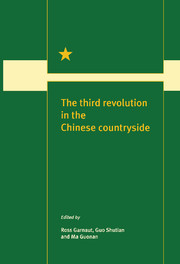Book contents
- Frontmatter
- Contents
- Figures
- Maps
- Tables
- Contributors
- Preface
- 1 The third revolution
- Feeding the people
- Marketing and price reform
- Internationalisation
- Regional issues
- 15 The grain economy of Guangdong: internationalisation or East Asian style protectionism?
- 16 Grain production and regional economic change
- 17 Regional inequality in rural development
- Institutional change
- References
- Index
16 - Grain production and regional economic change
from Regional issues
Published online by Cambridge University Press: 04 August 2010
- Frontmatter
- Contents
- Figures
- Maps
- Tables
- Contributors
- Preface
- 1 The third revolution
- Feeding the people
- Marketing and price reform
- Internationalisation
- Regional issues
- 15 The grain economy of Guangdong: internationalisation or East Asian style protectionism?
- 16 Grain production and regional economic change
- 17 Regional inequality in rural development
- Institutional change
- References
- Index
Summary
Grain transfer between provinces and regions has long been a major issue in China's agricultural policy (Lardy 1990). Grain has to be transferred from the major producing areas to the large urban centres and it has always been necessary to adjust for varietal composition in regional supplies and to compensate for the vagaries of weather and local fluctuations in output. The appropriate balance between grain for human consumption and for animals has been an important issue with priority consistently given to human consumption.
Since 1978, the structure of grain production, pricing and marketing has passed through several phases of reform (Lin, chapter 2; Huang, chapter 3). Economic growth, by transforming both demand and supply, has added a different dimension of change. In terms of demand, increases in income have encouraged a change in consumer's diets (Garnaut and Ma, chapter 4). As a consequence, the proportion of grain consumed directly is declining and that consumed through animal products is increasing. This change has consequences for both regional transfers within China and for the structure of China's international grain trade.
In terms of supply, peasant households are now sharply aware of their opportunity costs. Fluctuations in grain production since 1984 have, in part, reflected producer's desire to move to higher-value crops. The management of grain production now has to take into account producer incentives, and, given the problems of handling this issue successfully in a semi-reformed economy, it is not surprising, after a brief period of relaxation, that governments throughout China in the late 1980s again shifted towards greater coercion in grain production through the system of fixed contracts.
- Type
- Chapter
- Information
- The Third Revolution in the Chinese Countryside , pp. 218 - 241Publisher: Cambridge University PressPrint publication year: 1996



